The Mumbai local trains, often called the city’s lifeline, play a vital role in making it the city of dreams.
Having embarked on a mission to visit every state in India, I found Mumbai to be a fascinating mix of heritage, chaos, modernity, and magic. The local trains play a big part in that.
I loved the convenience and fun of zipping through the commercial capital of India on these budget-friendly rails.
But I was nervous for my first trip, especially after watching videos of uber-crowded cars and aggressive commuters.
Fear not, though. I’ll cover common topics about the how to travel Mumbai local trains, like:
- The various train routes
- The best destinations for tourists
- Which train should I take: fast or slow?
- What are the timings of the local train?
- How to buy a ticket
- How to use the automated ticket vending machines
- How to find the right train
- Seating on the local trains
- Common tourist mistakes when riding the local train
- Tips for safely riding the local train
- History of Mumbai’s local train
You won’t want to miss a section, since your first trip can be overwhelming. Let me walk you through my firsthand account and spill some expert beans on navigating this vast network!
Let’s cover everything about Mumbai’s iconic transport option, the local trains!
Planning a trip to India at some point? Check out my free ebook to help you save time and money, and avoid headaches. After +4 years in India, I’ve made plenty of mistakes, and this guide shares what I’ve learned so you can have a smoother trip.
Mumbai Local Train Routes
Mumbai’s local train system isn’t just a mode of transport. For many, it’s an experience, an emotion, and a way of life.
Each line runs for over 100 kilometers (62 miles), and over 7.5 million people commute daily via this network!
Western Line
From Churchgate to Virar – This line will take you through the city’s business hubs and some classic hangout spots.
Central Line
From CSMT to Kalyan and beyond – Venture through Mumbai’s heart, with key stops holding historical and cultural significance.
Harbour Line
From CSMT to Panvel and Andheri – This line traces Mumbai’s eastern coastal areas, a treat for explorers.
Fun Fact: Mumbai’s railway system is one of the oldest in Asia, with its roots tracing back to 1853.
Read the full post about Getting Around India, including by air, train, bus, rickshaw, and even elephant. Every traveler needs to read this.
Best Local Train Destinations for Tourists
Planemad, CC BY-SA 2.0, via Wikimedia Commons
Each station offers a unique experience:
– Churchgate: Not far from Marine Drive, you will be enchanted by the historical architecture.
– Dadar: Dive into the bustling markets near the station. Central and Western share this stop, and suburban railway stations are nearby.
– Andheri: Enjoy Versova Beach’s serene view. It serves the Western and Harbour lines
Pro Tip: With so much foot traffic nearby, look for street food near the stations. In Dadar, I encountered a local vendor selling the most delectable ‘vada pav.’ That spontaneous food trip remains one of my fondest Mumbai memories!
Read more: The Best Time To Visit India’s Most Popular Destinations
Local Train Hours of Operation
| Station | First Train (from CSMT) | Last Train (from CSMT) | Peak Hours | Major Attractions |
| Churchgate | 4:25 AM | 12:15 AM | 7-10 AM & 5-8 PM | Marine Drive & Historical Buildings |
| Dadar | 4:15 AM | 12:45 AM | 7-10 AM & 5-8 PM | Bustling Markets & Local Food |
| Andheri | 4:45 AM | 12:00 AM | 7-10 AM & 5-8 PM | Versova Beach & Modern Eateries |
| Bandra | 4:40 AM | 12:20 AM | 7-10 AM & 5-8 PM | Shopping Streets & Local Hangouts |
| Borivali | 5:00 AM | 11:45 PM | 7-10 AM & 5-8 PM | National Park & Peaceful Areas |
The first train chugs out at around 4:00 AM, and the last train winds up the day by midnight.
Peak hours? Morning 7-11 and evening 5-9. Best avoided unless you’re up for a *real* challenge.
Pro Tip: Want to see what it’s like on Mumbai local trains during rush hour, but not ready to experience it? Go check out a main station but just watch from a bench with some chai. It’s better than a football game.
Read more: The Best Gifts To Take From The USA To India
Which Local Train Is Best: Slow or Fast?
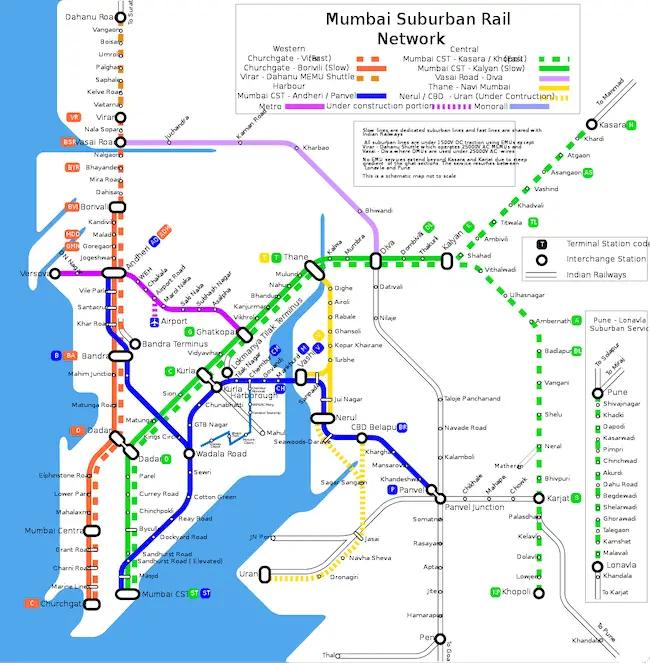
Ever heard the terms “slow” and “fast” trains and wondered what the fuss is about?
Slow Trains
They stop at every station, making them great for short distances. But, during peak hours, it’s a bit of a hustle. Opt for a slow train during off-peak hours if you’re not in a rush. You’ll get to enjoy the city’s rhythm without the rush!
Fast Trains
These skip several stations and are ideal for longer distances.
Pro Tip: Beware of taking the fast trains on your first trip. Since they don’t stop at every stop, you must ensure the train stops at your station. I made this mistake on one of my first trips!
Read more: Common Mistakes Travelers Make in India
How To Buy Tickets and Passes

Navigate through the ticketing process easily:
1. Approach the Ticket Counter for a manual ticket.
2. Download the UTS Mobile App for digital tickets.
3. If staying longer, get a Tourist Pass for unlimited journeys.
Pro Tip: Avoid morning rush hours when buying tickets at the counter. The queues can be daunting!
Read more: Indian Airport Travel Tips
Train Seating
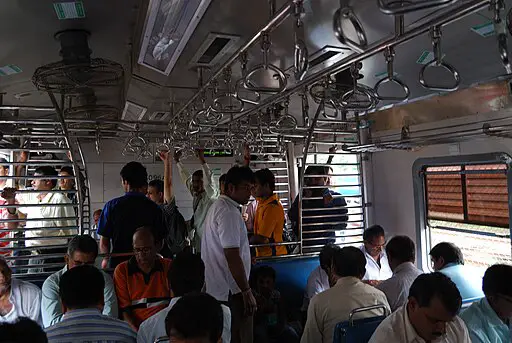
Two options are available: First Class and Second Class. While the first class offers a bit more space, the second class gives you an authentic experience. Designated coaches for women and senior citizens are available.
I didn’t see much difference between the seats and there are many more second class options.
Pro Tip: If you’re traveling long, try securing a window seat. The changing landscapes are a treat to the eyes!
How to Use Automatic Ticket Vending Machines on Mumbai’s Local Trains
Ah, the world of technology! If you’re keen on skipping those sometimes endless ticket queues (and trust me, during peak times, you might want to), Mumbai’s local trains have a nifty solution: Automatic Ticket Vending Machines (ATVMs).
Here’s a quick and easy guide for you to get that ticket and hop onto your next adventure.
1. Locating the Machine:
You’ll find ATVMs at every major railway station in Mumbai. They’re usually near the entrance or the manual ticket counters.
2. Choose Your Language:
The machines often provide options for multiple languages. Simply touch the screen to select your preferred language – typically, English and Hindi are the most commonly used options.
3. Select the Type of Ticket:
You can choose between a single journey ticket, a return ticket, or a platform ticket. Touch the option that suits your requirement.
4. Choosing Your Destination:
A list of stations will appear on the screen. Scroll through and select your desired destination. If you’re unsure of the station name, check a Mumbai local train map or ask a friendly local nearby.
5. Payment:
Insert the exact change into the machine. Some ATVMs might also accept larger notes or even provide change, but it’s best to have the exact amount to avoid any hiccups.
6. Collect Your Ticket:
The machine will print out your ticket once your payment is accepted. Ensure you take it along with any change provided.
7. Smart Cards:
For those planning to travel frequently or even if you’re in Mumbai for a week or so, consider getting a Smart Card. It allows you to preload a certain amount and use the ATVMs without fumbling for change each time. Plus, it’s super convenient!
Pro Tip: Keep the ticket safe to show to any ticket checkers and because you might need it to exit some of the bigger stations.
It might seem daunting at first, especially if there’s a queue behind you, but take a deep breath. With a couple of tries, you’ll be using ATVMs like a pro! And always remember, when in doubt, ask. Mumbaikars are always ready to help, and who knows, you might just make a new friend.
Read more: How To Exchange Money in India (and Avoid ATM Fees)
How to Find The Right Train
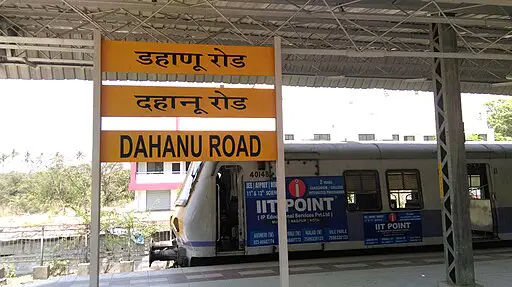
Mumbai’s train system is vast but not complicated if you know the basics:
– Indicators & Boards: These are your best friends. Always updated with the train’s destination and timing.
– Announcements: They might be fast and in multiple languages, but they’re essential.
Pro Tip: Most locals are friendly. If in doubt, ask someone nearby. Mumbai’s unity in diversity shines on its local trains.
Read more: Top 50 Street Foods in India
Common Mistakes Tourists Make on Mumbai’s Local Trains
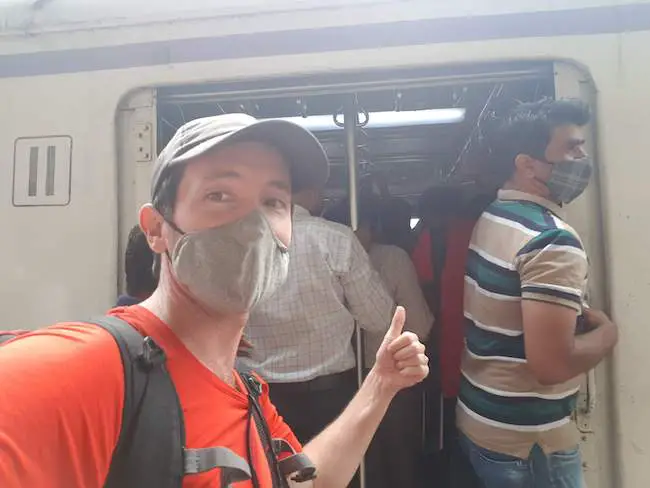
As someone who’s been there and done that (more times than I’d like to admit), here are some of the most common slip-ups I’ve made or noticed tourists often make.
Let’s help you sidestep these for a smoother ride.
1. Getting on the Wrong Carriage:
There are separate carriages for women, and some are specifically reserved during peak hours. Always check the signage and, when in doubt, ask a local. They’re generally more than happy to point you in the right direction.
If you get it wrong, you can easily switch carriages so don’t worry you won’t face jail time!
2. Waiting for Empty Trains:
Ah, the optimism! Mumbai’s local trains, especially during rush hours, are… well, let’s just say ‘bustling’ is an understatement. If you wait for an empty train, you might be waiting forever.
Pro Tip: During peak hours, aim for the first or the last compartments, which tend to be slightly less crowded.
3. Hesitating:
When the train arrives, and there’s a sea of people, it’s natural to hesitate. But that split-second delay can mean missing your train.
Pro Tip: Know which door you’ll be exiting from before your stop arrives. Stand ready and move with the flow.
4. Not Keeping Personal Belongings Safe:
Just like any crowded place in the world, there’s always a slight risk of pickpocketing.
Pro Tip: Use a money belt or a front-facing backpack. Always be aware of your belongings, especially in dense crowds.
5. Mispronouncing Station Names:
I once asked a local for directions to ‘Versova’ (mispronounced), and got sent on a wild goose chase. You can show a photo of the name on your phone to be sure.
Pro Tip: Listen to the announcements or ask multiple people if unsure. Sometimes the pronunciation can make all the difference!
6. Avoiding Eye Contact:
In many cultures, avoiding eye contact is polite. But a friendly nod or a brief smile can make your journey more pleasant. Mumbaikars are friendly, and a small gesture can lead to a heartwarming conversation.
Pro Tip: Don’t be shy to strike up a chat. You might just end up with a local tip or two.
While these might seem daunting, remember that every traveler, including yours, has had their share of blunders. Embrace them, laugh them off, and keep moving. Mumbai awaits, and its local trains are the best way to truly feel the city’s pulse.
Read more: The Best Travel Hacks for India
Tips for Safely Riding The Train

Safety is paramount:
– Stay Alert: Beware of pickpockets, especially during rush hours.
– Boarding/Alighting: Wait for the train to halt completely.
– Train Etiquette: Respect it. Mumbai takes its train etiquette seriously.
Pro Tip: Always carry a small water bottle, especially during summer. Mumbai’s humidity combined with the train’s hustle can be draining!
My Mumbai Local Train Experiences
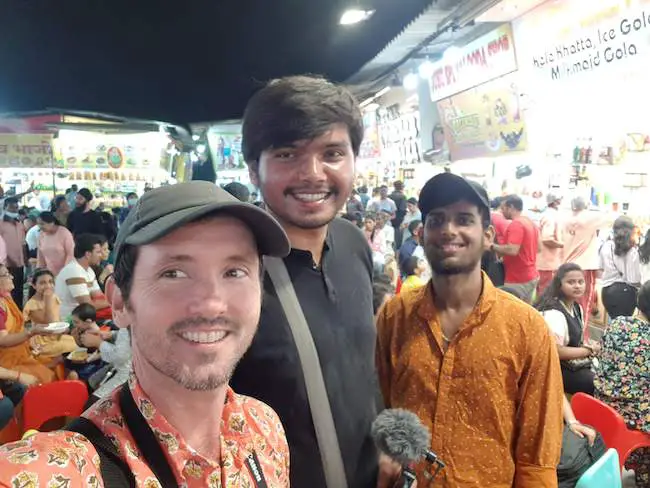
I stayed near Marine Drive to take the train from Churchgate north to Bandra. There’s a great beach there with street food named Juhu Beach, which you can reach from the Santacruz station.
On off-hours, there is plenty of space. I was able to shoot a video and get great shots of the city as it woke up.
I took a peak-hour train, and there was some pushing and shoving. I ensured I was far enough inside the train to be clear of the doors as we sped through the stations.
But I did make one local mad. He was trying to push by me and asked me to move so he could get by. Well, I couldn’t go anywhere and give him any space, so he had some harsh words for me. But he made it past fine though, so no harm was done.
Everyone else was friendly and helpful. I made friends in the ticket line and asked about how to board, and tips from a local girl.
Overall, it’s an experience you’ll want to have in Mumbai. And it beats sitting in traffic, which can be pretty jammed.
Mumbai’s Local Trains: A Glimpse into Their Fascinating Past
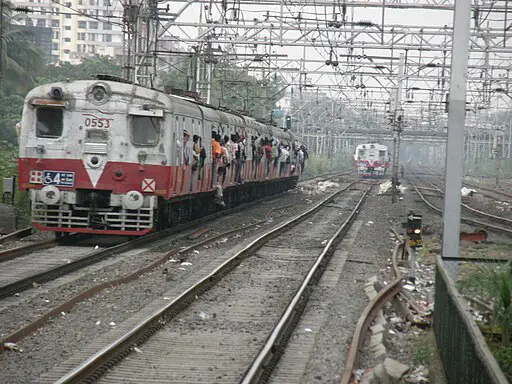
When I rode theMumbai local, amidst the cacophony and crowds, I enjoyed thinking about what it must have been like ridign these trains over a hunrded years ago.
These trains are more than just a mode of transport – they’re a living testament to Mumbai’s ever-evolving saga.
Here are some intriguing highlights from the tapestry of Mumbai’s local trains:
1. The Birth of a Legacy – 1853:
Can you believe that Mumbai’s train system is over a century old? The first train in India ran between Bori Bunder (now Chhatrapati Shivaji Maharaj Terminus) and Thane on April 16, 1853. It marked the start of Mumbai’s love affair with local trains and India’s tryst with railways.
2. The Transition to Electric:
Initially, steam locomotives pulled these trains, belching out clouds of smoke. But come 1925, Mumbai saw its first electric train, a massive leap forward in efficiency and speed. The line? Between Bombay VT (Victoria Terminus) and Kurla.
Fun Fact: The decision to electrify the railways was taken in 1915, and it took a whole decade for the dream to become a reality!
3. The Introduction of the Iconic DC/AC System:
In the early days, Mumbai’s trains ran on a Direct Current (DC) system. However, this system wasn’t energy-efficient. After years of planning and groundwork, by 2012, the entire Mumbai local train network transitioned to the Alternating Current (AC) system, marking a significant technological advancement.
4. Ladies’ Special – Empowering Women since 1982:
On May 5, 1982, Mumbai introduced a monumental train service – the “Ladies’ Special.” Dedicated exclusively to women, this initiative ensured safer and more comfortable travel for the city’s female populace.
5. More than Just Trains – Lifelines:
During Mumbai’s devastating floods in 2005, when most of the city came to a standstill, the local trains played a pivotal role. They resumed operations faster than most other services, becoming a beacon of hope and resilience for the city. It was a stark reminder of their crucial role in Mumbai’s daily life.
6. Architectural Wonders:
Many of Mumbai’s train stations, like the Chhatrapati Shivaji Maharaj Terminus (CSMT), are architectural marvels and have historical significance. CSMT, formerly known as Victoria Terminus, is a UNESCO World Heritage site, celebrated for its Victorian Gothic Revival architecture.
7. Platform Tales:
Dadar station, one of Mumbai’s busiest, sees footfalls equivalent to the entire population of a small country every day! It’s a bustling hub connecting the Western and Central railway lines. The first time I visited, the sheer number of people left me awestruck. It truly epitomizes the phrase ‘Mumbai never stops’.
Every hum, rattle, and rhythm of the local trains tells a story – tales of progress, a city’s growth, dreams, and challenges. As you travel on these trains, remember you’re not just commuting. You’re becoming a part of Mumbai’s rich, enthralling history. Enjoy the journey!
FAQ
Is the Mumbai Local Train safe for tourists?
Absolutely, just maintain general vigilance. Watch your belongings, be polite, and move with the flow. Stay clear of the doors and don’t try hanging out the door for a great photo. People die every year riding the local train
How do Mumbai locals feel about tourists?
Mostly warm and welcoming, but avoid photographing without permission. Be ready to move with the flow of traffic. Be sure to let those coming and going have space, even this means doing some pressing yourself. Personal space is not too common during rush hour on the local trains.
Final Thoughts
Navigating the Mumbai local trains might seem daunting initially, but with the right insights and a bit of local knowledge, you’ll master the art in no time.
Remember, learning how to travel Mumbai’s local trains is not just about getting from point A to point B. It’s about immersing yourself in the city’s vibrant rhythm, connecting with its soul, and witnessing the spirit of Mumbaikars firsthand.
So, the next time you’re on the platform, ticket in hand, waiting for your train, take a deep breath, embrace the adventure, and know that you’re about to experience one of the most authentic aspects of life in this incredible city. Safe travels and happy riding!

